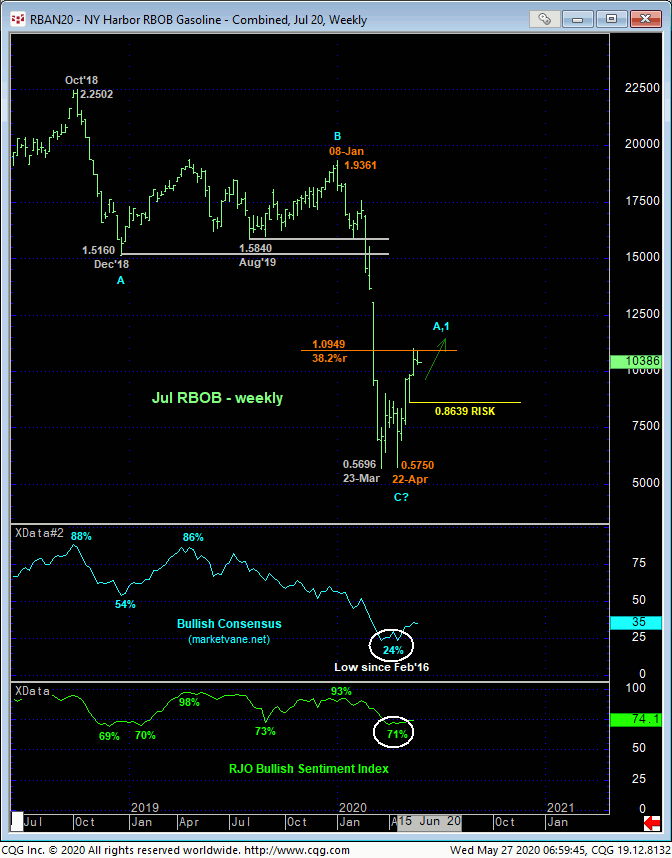
JUL CRUDE OIL
There’s little question that the extent and impulsiveness of the past five weeks’ rally is sufficient to suggest that 21-Apr’s 6.50 low ENDED the secular bear market. Having retraced roughly 50% of Jan-Apr’s meltdown and giving the relative size of that meltdown, it would be short-sided to believe that there’s little risk of at least a (B- or 2nd-Wave) corrective rebuttal to this rally OR a (5th-Wave) resumption of the secular bear. The extent to which the managed Money community has flooded back to the bull side provides fuel for downside vulnerability IF/when the market confirms a bearish divergence in momentum needed to break the clear and present uptrend. Indeed, at a current 90% level representing a whopping 392.5K long positions to just 44K shorts, it’s not hard to see the potential for a sharp relapse if the overall market forces the capitulation of some of this historically-skewed bullish exposure. The key technical factor that would bring sentiment/contrary opinion into the peak/reversal-threat equation is MOMENTUM.
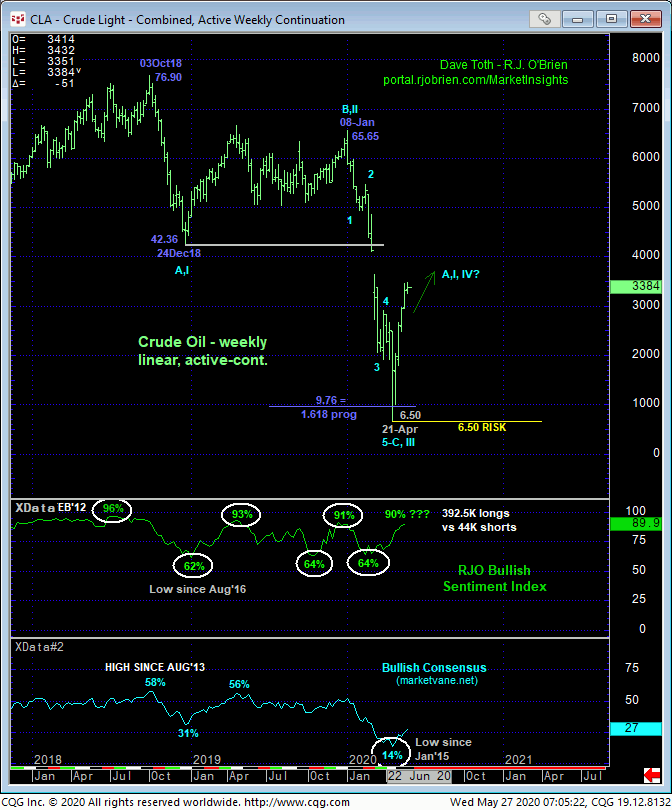
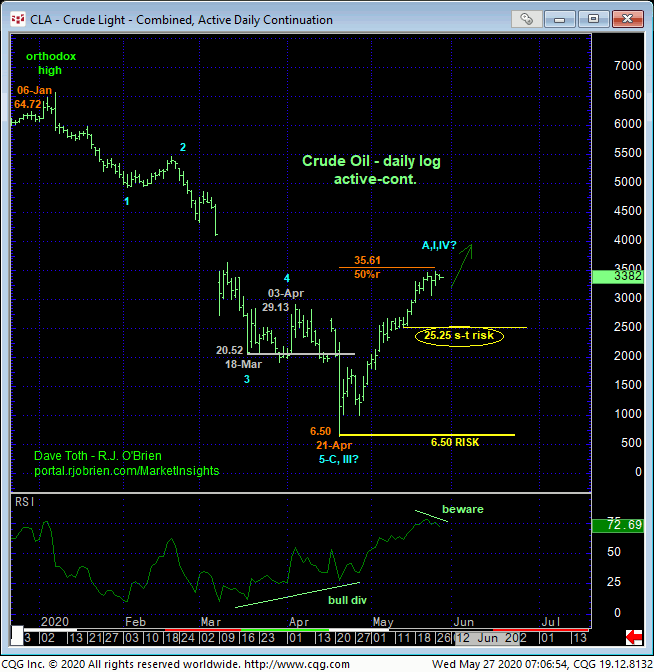
Since early basing behavior introduced in 30-Apr’s Technical Blog, the trend has been one-way north. There was a divergence threat in mid-May, but resumed gains chalked up that price action as merely consolidative. Both the daily chart above and certainly the 240-min chart below show once again the developing POTENTIAL for a bearish divergence in momentum. As a result of yesterday’s poke to yet another new high, the market has identified Fri’s 30.72 low as the latest smaller-degree corrective low it now is required to sustain gains above to maintain a more immediate bullish count. Its failure to do so will confirm a bearish divergence in very short-term momentum and reject/define a more reliable high and resistance from which the risk of non-bullish decisions like long-covers and cautious bearish punts can then be objectively based and managed.
If/when the market fails below 30.72 however, the question/challenge will become one of SCALE, and whether that very minor (relative to the broader uptrend) mo failure is sufficient to conclude the END of the rally from 21-Apr’s 6.05 low. Certainly, more significant proof of weakness below 13-May’s 25.25 corrective low would be of a sufficient scale to conclude the end of Apr-May’s rally and a larger-degree correction or reversal lower. What lies between 30.72 and 25.25 is anybody’s guess. What would be a fact however is the rejected/define high (34.81 currently) following a sub-30.72 failure. Traders making non-bearish decisions following “just” a sub-30.72 failure would be acknowledging and accepting whipsaw risk (above 34.81) in exchange for the benefit of not incurring deeper nominal risk below 25.25.
These issues considered, traders are advised to maintain a bullish policy and exposure with a failure below 30.72 required for shorter-term traders to pare or neutralize bullish exposure. Subsequent and commensurately larger-degree weakness below 25.25 would be sufficient for even long-term players to neutralize exposure in order to circumvent the depths unknown of what we’d suspect is just a correction or Apr-May’s rally and not a resumption of the secular bear trend (although this latter possibility would the exist). There are no technical levels of any merit below 25.25, so maintaining bullish exposure below this threshold accepts very long-term risk to 21-Apr’s 6.05 low. Until the market fails below at least 30.72, the trend remains up on all practical scales and should not surprise by its continuance.
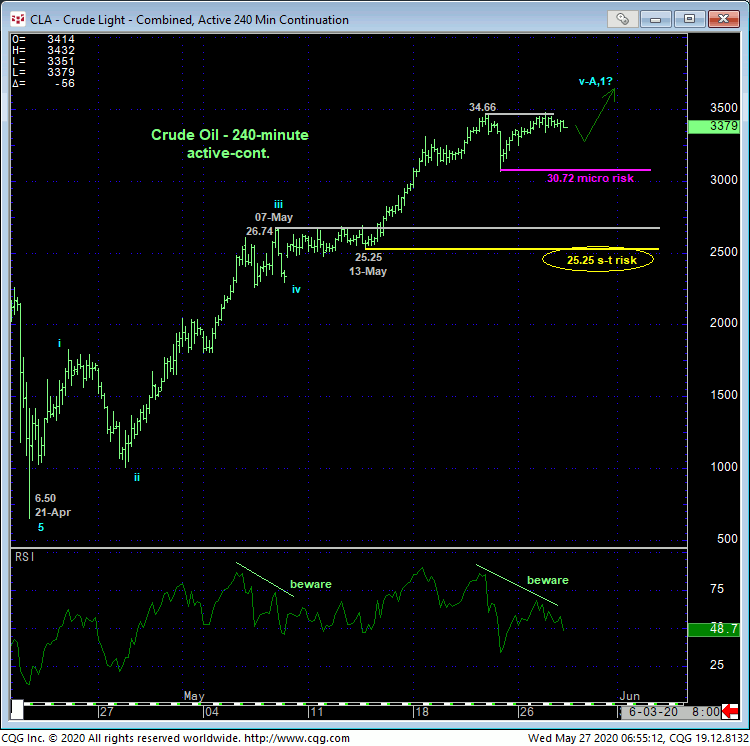
JUL HEATING OIL
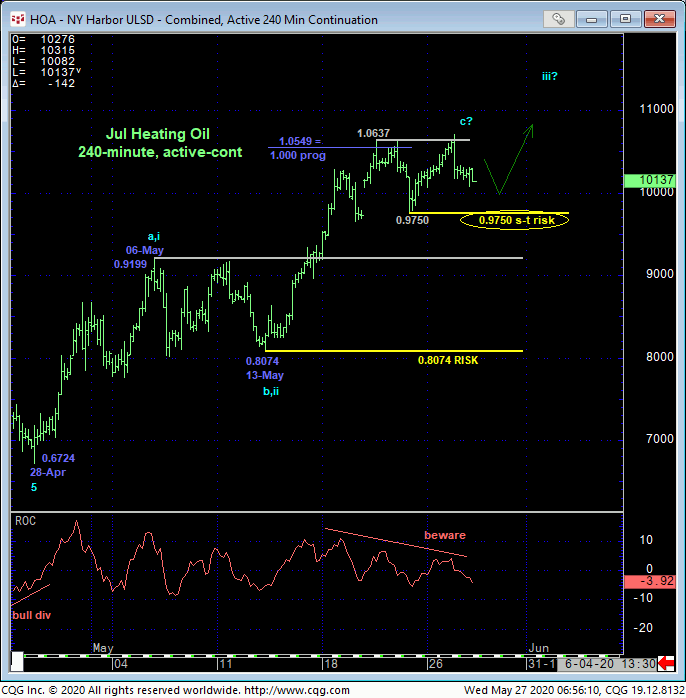
For most intents and purposes the technical construct and expectations for heating oil are the same as those detailed above in crude, with Fri’s 0.9750 low and 13-May’s 0.8074 low considered the latest smaller- and larger-degree corrective lows the market now needs to sustain gains above to maintain a more immediate bullish count. Per such, these levels represent our short- and longer-term risk parameters to a still-advised bullish policy.
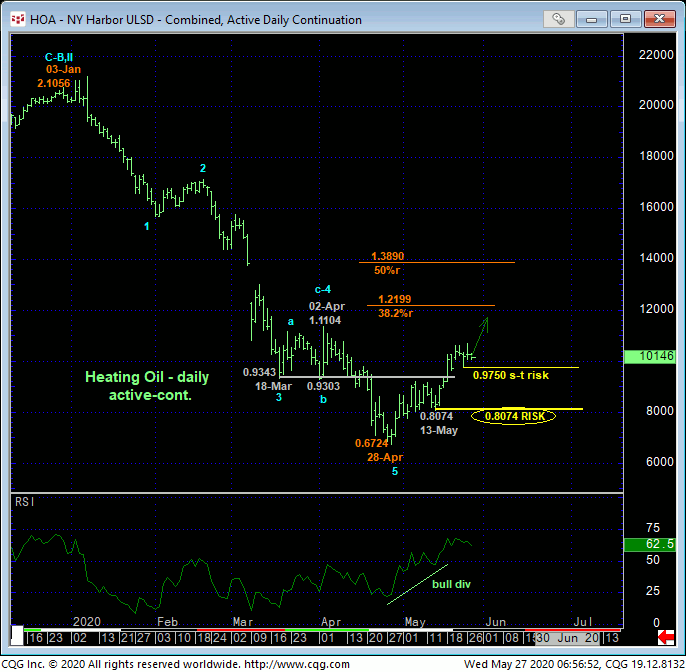
Differences to the crude oil count however are that this market has retraced a more minimal (approx 38.2%) of Jan-Apr’s collapse that more easily may be considered a mere (4th-Wave) bear market correction while market sentiment levels remains historically low, warning of still further upside vulnerability.
These issues considered, a bullish policy and exposure remain advised with a failure below 0.9750 required for shorter-term traders to step aside and commensurately larger-degree weakness below 0.8074 required for longer-term players to follow suit. In lieu of such weakness, further and possibly accelerated gains should not surprise.
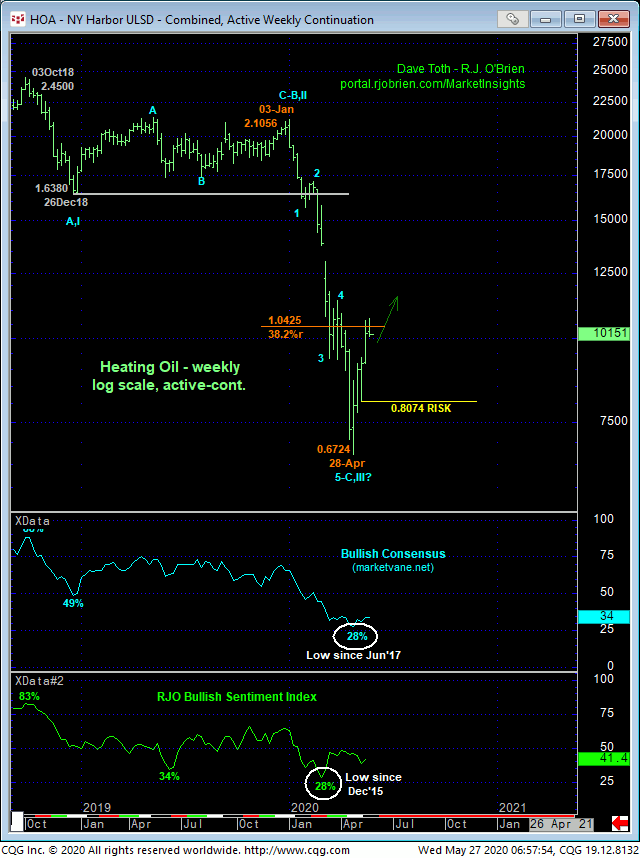
JUL RBOB
Finally, the 240-min chart of RBOB below shows Fri’s bearish divergence in very short-term momentum below 1.0381 that leaves 20-May’s 1.0999 high in its wake as one of developing importance and the obvious level the market needs to recoup to reinstate the bull. Per such, we’re identifying 1.1000 as a very tight but objective risk parameter from which non-bullish decisions like long-covers and cautious bearish punts can be objectively based and managed.
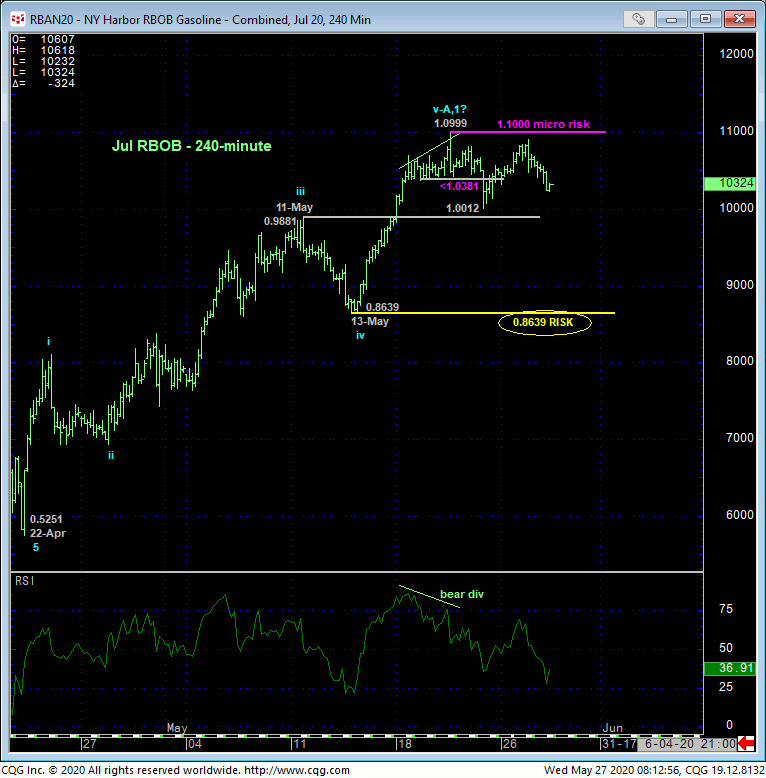
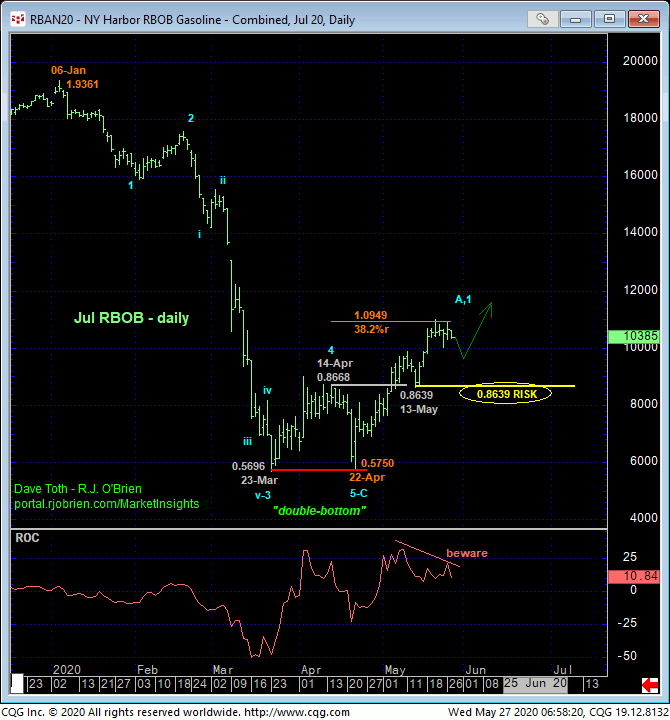
From a longer-term perspective looking at the daily chart above, it is clear that Fri’s mo failure is of an insufficient scale to conclude the end or top of the rally from 22-Apr’s 0.5750 low. Indeed, commensurately larger-degree weakness below 13-May’s 0.8639 large-degree corrective low is required to, in fact, confirm a bearish divergence in momentum of a scale sufficient to break Apr-May’s uptrend.
Here to, as with diesel, market sentiment levels remain depressed and consistent with a continued bullish policy. By the same token, this market has only retraced a Fibonacci minimum 38.2% of Jan-Apr’s meltdown that remains well within the bounds of a mere (4th-Wave) correction within the secular bear.
These issues considered, shorter-term traders are advised to pare or neutralize bullish exposure with a recovery above 1.1000 required to negate this call, reinstate the bull and expose potentially sharp gains thereafter. Commensurately larger-degree weakness below 0.8639 remains required for long-term players to move to neutral.
